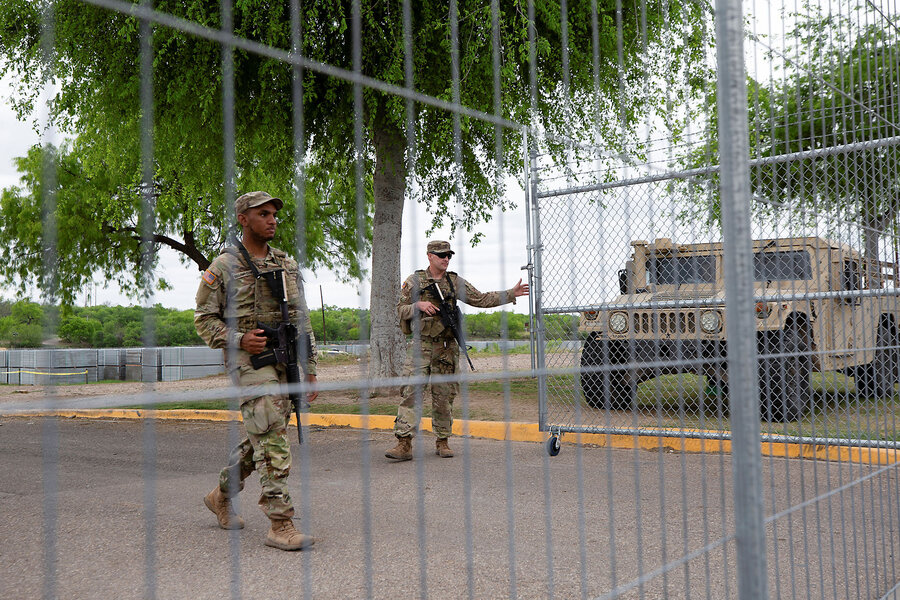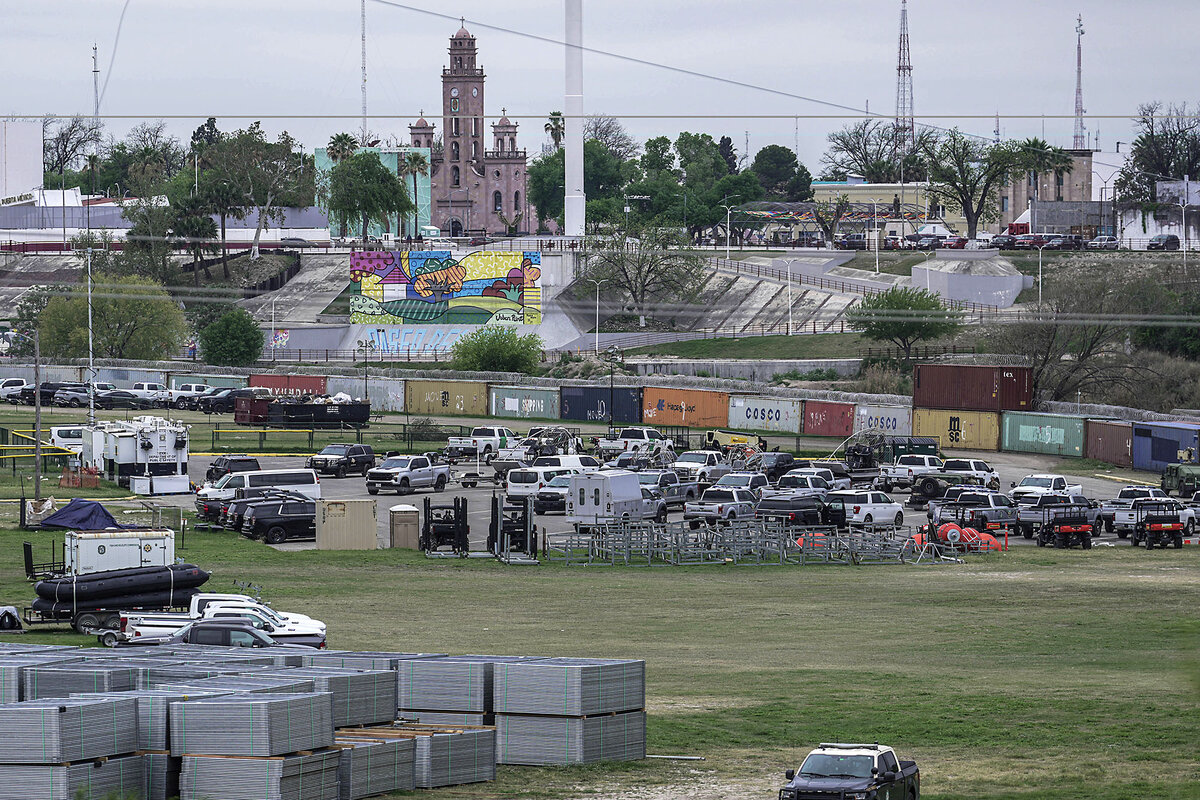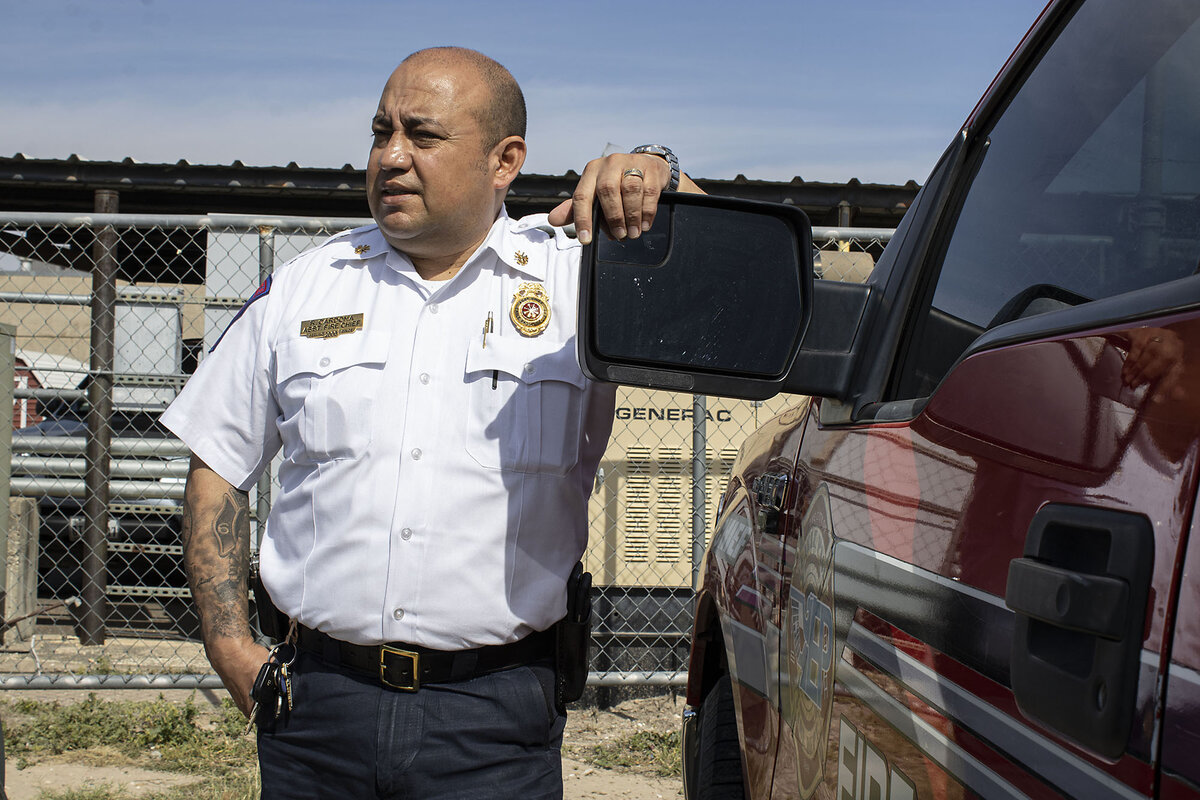Texas National Guard tests state authority on US southern border
Loading...
| Eagle Pass, Texas
Shelby Park was once a popular spot for locals to play soccer or walk their dogs along the Rio Grande. Today National Guard troops from Texas patrol the park that – now rimmed with spiraled wire – is seen as a front line in a national debate over U.S. border security.
The municipal park in Eagle Pass, Texas, has been transformed in recent months in an escalation of Gov. Greg Abbott’s Operation Lone Star, a border security effort now 3 years old. The state’s use of National Guard and other state law enforcement has ratcheted up tensions with the federal government.
The state seized the park from the city unexpectedly in January, and the Department of Homeland Security accused Texas of blocking U.S. Border Patrol agents from accessing it. Governor Abbott visited in February alongside 13 fellow Republican governors, many of whom are sending members of their National Guard to support Texas’ border initiative. Former President Donald Trump also praised the state’s “military operation” when he visited Shelby Park in February.
Why We Wrote This
A story focused onIn response to an increase in illegal border crossings, Texas is trying a new, confrontational approach to using its National Guard. We look at how National Guard use has evolved.
National Guard deployment to the border isn’t new. For decades, governors and presidents of both parties have called up these troops to support local, state, and federal agencies. What’s new, say legal experts, is a state’s use of the National Guard as an overt political challenge to federal immigration authority. Dangerous, unlawful border crossings, meanwhile, continue.
“The use of the Guard for things that are customarily federal duties, coupled with the political environment we’re in, coupled with the renewed assertion of states’ rights – to me, it’s more than somewhat problematic,” says Joshua Kastenberg, a former Air Force lawyer and judge, now professor at the University of New Mexico School of Law.
From militias to National Guard
The National Guard, a state-based, reserve U.S. military force, grew out of militias that predated the nation. Congress introduced standardized training and federal funding in 1903, helping transform the National Guard into a modern force. National Guard troops are now deployed regularly across the United States, including for natural disaster response, COVID-19 testing, and recently the patrolling of the New York City subway. Massachusetts activated up to 250 National Guard troops last summer to help migrants access food and medical care at shelters.
Governors, the president, and Congress can all activate the National Guard. The federal government is prohibited from using the National Guard as a civilian police force (unless authorized by the invocation of a law like the Insurrection Act). States, however, generally have more leeway.
Within a state role, the National Guard has “always been able to support, or even function, in a law enforcement capacity,” says Joseph Miller, senior historian at the National Guard Bureau.
After Border Patrol tracked a record-high number of migrant encounters along the southern border in December, Texas installed itself in Shelby Park the following month. The state refused to comply with a Department of Homeland Security “cease and desist” letter demanding full access, which alleged that the presence of state troops in Shelby Park obstructs federal Border Patrol operations.
Texas’ actions “improperly seek to regulate the federal government,” persisting “even in instances of imminent danger to life and safety,” Jonathan Meyer, general counsel for the U.S. government, wrote in the letter.
Also in January, the Supreme Court sided with the Biden administration in a 5-4 vote, allowing federal agents to cut through state-installed wire in order to perform their duties.
The ruling also left key concerns unanswered around the broader state-federal conflict. The court “could have answered the questions” of whether Texas’ use of its National Guard is unconstitutional, “but courts don’t do those things unless they have to, usually,” says William Banks, professor emeritus at the Syracuse University College of Law.
“No state can use the National Guard in a way that offends the United States Constitution, or the supremacy of federal law,” says Professor Banks. “What’s going on now in Texas, viewed a certain way, is Abbott is interfering in a federal power over immigration.”
Border authority
Texas officials say they’ve taken these actions out of necessity, due to the federal government’s neglect of its border security responsibility. Migrants have crossed illegally in record numbers during the Biden administration, with an average of 2 million annual Border Patrol encounters along the entire southern border since 2021, the highest levels on record.
“Until President Biden steps up and does his job as Commander-in-Chief to secure the border, Texas will hold the line and use every tool and strategy to keep our country safe,” Governor Abbott said in a statement last month.
The Texas governor’s office says the state’s efforts are paying off, citing “over 503,800 illegal immigrant apprehensions and more than 40,400 criminal arrests.” Critics cast Operation Lone Star as ineffective, subject to civil and human rights abuse, and expensive. The first two years of the operation cost around $4 billion, according to news reports. Further appropriations passed by the state legislature could push the state’s border spending to over $11 billion through 2025.
Border Patrol encounters have dropped along the Texas-Mexico border over the last five months compared with the same period last fiscal year, although encounters are rising elsewhere in Tucson, Arizona, and San Diego, California, sectors.
Two-thirds of Texas voters support the deployment of more state police and military resources to the border, according to a February poll. The Texas Military Department did not respond to a request for comment, and U.S. Customs and Border Protection declined to comment on the record.
Along the Texas-Mexico border, the use of state troops expands beyond Eagle Pass.
Further west, on the border in El Paso, a viral video released by the New York Post in March shows a crowd of migrants, several with their hands raised, pushing past Texas National Guard members. (Under U.S. law, individuals may apply for protections like asylum, even if they entered illegally, as a defense against removal.)
To Adolpho Telles, the El Paso County Republican Party chairman, the incident represents an “attack on this country.”
“The Texas National Guard should not have to be doing what they’re doing, but because the president is not living up to his pledge to support the Constitution of the United States, the state of Texas needs to protect its citizens,” says Mr. Telles.
Governor Abbott has also announced plans to build a military-style base to house National Guard troops on 80 acres of land in the Eagle Pass area. The site will be able to hold up to 2,300 service members previously located in hotels around the region. Meanwhile, some locals say the state’s show of force is excessive. They also want their park back.
With Shelby Park generally closed to the public, the Eagle Pass City Council moved their upcoming solar eclipse festival to another venue, according to the Eagle Pass Business Journal. The city’s mayor told local media that the park was taken over by the state without notice or consent.
The saga is emblematic of a broader trend around state challenges to federal authority, says Amerika Garcia Grewal, a local who helps organize vigils at the park that honor migrant lives lost in the Rio Grande.
“It has the potential to tear our union apart,” says Ms. Garcia Grewal. “Here in Eagle Pass, Governor Abbott has found a pressure point, and he’s hammering it on as hard as he can. And he’s sending cracks out throughout the entire United States.”
The Department of Justice has so far resisted suing Texas over its takeover of Shelby Park and restrictions on Border Patrol agents. The Biden administration has considered litigation, but doesn’t want to further escalate conflict, according to NBC News.
Meanwhile, the Biden administration has sued Texas over other efforts to expand state immigration authority. Litigation is ongoing over a buoy barrier installed by Texas in the Rio Grande, and a new law that would permit state officials to arrest and deport migrants who crossed the border illegally.
“Let’s ... put the guardsmen in there”
Texas isn’t alone in calling up its National Guard to manage its border. Arizona Gov. Katie Hobbs in December authorized the state National Guard to assist border counties with fentanyl and human trafficking enforcement. “Arizona has borne the burden of federal inaction in managing the State’s southern border,” the Democratic governor wrote in an executive order.
“We’re ready to support as long as needed,” says Capt. Erin Hannigan, spokesperson for the Arizona National Guard. The length of time depends on the “governor’s office and the counties that are requesting this support.”
For this fiscal year, the Department of Defense has also authorized the use of up to 2,500 National Guard troops to support federal immigration authorities along all four southern border states, mobilized from around half of all U.S. states and Guam. These border missions have been exercised by both red and blue commanders in chief.
“It’s nothing new,” says Victor Manjarrez Jr., director of the Center for Law and Human Behavior at the University of Texas at El Paso and a retired Border Patrol official.
For instance, starting in 2006, Dr. Manjarrez recalls coordinating up to 6,000 National Guard troops at the southern border under Operation Jump Start. Launched by Republican President George W. Bush, the mission aimed to offset a deficit of Border Patrol agents, he says, by placing the National Guard in roles that didn’t involve patrolling the border.
“We took a good count of, ‘hey, what [Border Patrol] agents are doing nonagent things’” like vehicle maintenance, for example, he says. “Let’s get the agents out in the field; put the guardsmen in there.”
Local first responders
Back in Eagle Pass, state and federal personnel are not the only ones patrolling the Rio Grande. Local first responders also run their own missions. Eagle Pass emergency management services can still access the river, yet state-installed barriers along the banks mean that missions, including medical aid for those injured or body recovery for those who died, take longer, says Rodolfo Cardona, assistant fire chief.
The city’s emergency management coordinator stresses that, politics aside, the humanitarian crisis at the border continues. So does the mental health toll that his workers – and law enforcement – have increasingly borne while responding to illegal crossings. The crisis includes migrant children found injured, beaten, and raped.
“I don’t think it was ever a priority on our federal government’s mind – of the aftermath, and the toll it takes on not only us, but Border Patrol, the military, and everybody else,” says Mr. Cardona.
“All of this is tragic, in more ways than one,” he says. “These are human beings.”








